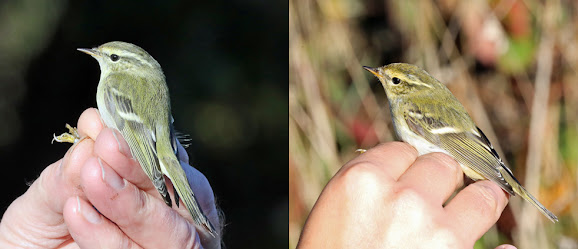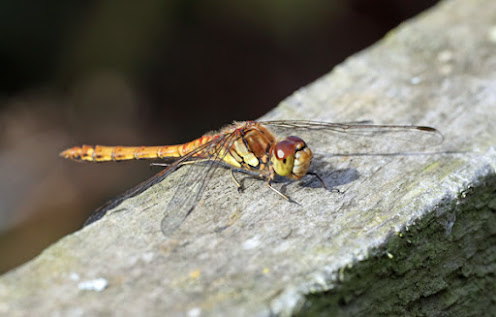MigWeek 2022
Jackie and I have been away to The East Riding Yorkshire for The Flamborough Observatory MigWeek 2022. This is the fourth time we have visited for this event and there is three reasons for that. 1. Everyone is so welcoming and friendly 2. Some good birding and 3. Excellent lectures.
From the birding side they have ringing demo’s, vismig every morning, also birding walks and every other evening a lecture.
We left home on the 7th Oct and arrived around six hours later at a Haven Holiday Park at Flamborough which turned out very convenient for most of the locations we wanted to visit.
Our first morning we headed to Flamborough Obs at the South Landing to the ringing demo, not expecting a great morning as the wind was in the southwest where it stayed all week which effectively totally wrong for good migration for this coastline. Nonetheless we were hopeful. When we arrived the ringing team had just arrived back from a net round with several full bags. By the end of the the morning had seen two Yellow-browed Warbler, Redwing, Blackcap several Wren, a couple of Treecreeper and Tree Sparrows. They also caught 13 Long-tailed Tit and as they release them all together so they don’t lose contact when they did it was like a bomb burst with birds going in all directions.
 |
| Two of several Yellow-browed Warbler seen Flamborough Obs. © Nick Hull |
 |
| Bittern- Thornwick Pools © Nick Hull |
Most mornings we would start the day at Flamborough Obs with the ringing and gauge what to do next on the amount of overnight migration there had been. Due to the wind direction most mornings were a little slow so we would head off somewhere else one such place was Hornsea Mere. The Mere can be very good and has aways turned up something on our previous visits. This year we arrived and things looked pretty quiet but we met a local birder intently scanning through distant wildfowl and he told us he had seen a Black-necked Grebe and a drake Greater Scaup in with the many Wigeon. So we joined him and after a while I managed to find the Scaup an immature male or perhaps one still in partial eclipse plumage and a short while later found the grebe. Whilst we were there the wildfowl numbers continued to increase as birds were flighting into the Mere and whilst directing another couple of birders towards where the Scaup was in the growing raft of duck four Whooper Swan flew in and settled giving there typical 'hooping' calls.
On another occasion we headed off inland to Top Hill Low this is a water treatment works reservoir. Our target species here was to find a Smew on the reservoir. Since we last visited here with a Two Owls group there had been a new hide/welcome centre built which was very nice but unfortunately not all the trails were open due to maintenance work. From the main hide we scanned the reservoir which had a good selection of wildfowl present with Wigeon, Shoveler, Teal, Tufted Duck, Pochard and of course Mallard also there were seven Whooper Swan.
 |
| Whooper Swan - Tophill Low © Nick Hull |
We found a Black-necked Grebe just left of the hide much closer than the one we saw at Hornsea. We continued our scanning and eventually another birder said he had found the Smew roughly half way along the reservoir with a few Coot and Tufted Duck. It was a nice red-headed female and she was busy diving regularly and would regularly disappear. We also found Goldeneye in fact around ten birds were on the water here, a species which was hard to find in the harbour at Poole last year. We also visited again the next day with friends and went to a different hide over looking a large pool with islands and here we had Green Sandpiper, Ruff, Curlew, Redshank, Little Grebe, Greylag Geese a single Pink-footed Goose and a small flock of Golden Plover, which added to our growing list.
 |
| Reeve & Ruff - Tophill Low © Nick Hull |
We also came across a few insects this very fresh Comma was a nice addition.
 |
| Comma Butterfly - Tophill Low © Nick Hull |
 |
| Common Darter - Tophill Low © Nick Hull |
On two other mornings we were up early and went to Hunmanby Gap this was where Keith Clarkson was taking an introduction to vismig for anyone who wanted to join him. We were also told it was good in a southwesterly wind. On our first visit on the12th October it was pretty mediocre with small numbers of Goldfinch, Linnet, Siskin, Chaffinch, Skylark Reed Bunting, and unlike home small numbers of wildfowl passage with Teal, Mallard, Wigeon, Greylag Goose and by far the largest numbers of the morning around 260 Pink-footed Geese. Apparently not all are going further south to Norfolk for two reasons one is that the farming practices have changed and there isn’t so much sugar beet being grown in Norfolk and the second is believed to be due to the milder climate and the geese are short stopping in Yorkshire, roosting on the Humber and flying north into the fields to feed during the day.
 |
| Flight of Pink-footed Geese - Hunmanby Gap © Nick Hull |
Our second visit was on the 16th and was much more productive in variety of species and we had an increase in numbers of most species compared to on the 12th. We added a number of species not seen on the previous visit such as Golden Plover a Great White Egret, House Martin, Song Thrush and Redwing, tree Sparrow, Rock Pipit, Lesser Redpoll and Yellowhammer.
Though Jackie and I are pretty experienced birders and vismig-ers we both learnt something from Keith’s vast experience watching from the site and little tips he passed on how to identify some of the species passing over. Keith must be one of the most enthusiastic birders I have met and it was a joy to spend a few hours in his company at Hunmanby Gap.
Looking back on this years Migweek the best bird this year must fall to the Barred Warbler which we saw on the 10th. We had visited Bempton and Hornsea in the morning and as it was quiet on the bird front we went into Bridlington to a little food shopping and fuel up the van. On the way back to the campsite news came on WhatsApp that a Barred Warbler had been found in the brambles near the Fog Station on Flamborough Head, so off we went.
 |
| Siskin, Barn owl, Treecreeper & Bullfinch © Nick Hull |

No comments:
Post a Comment